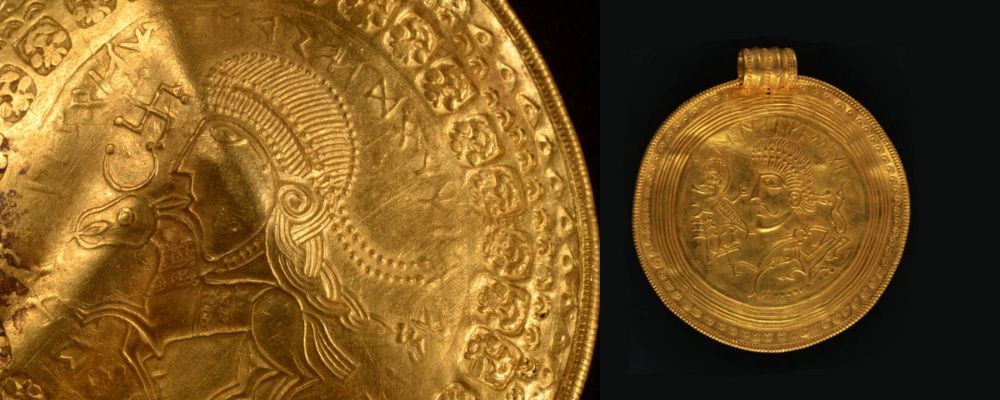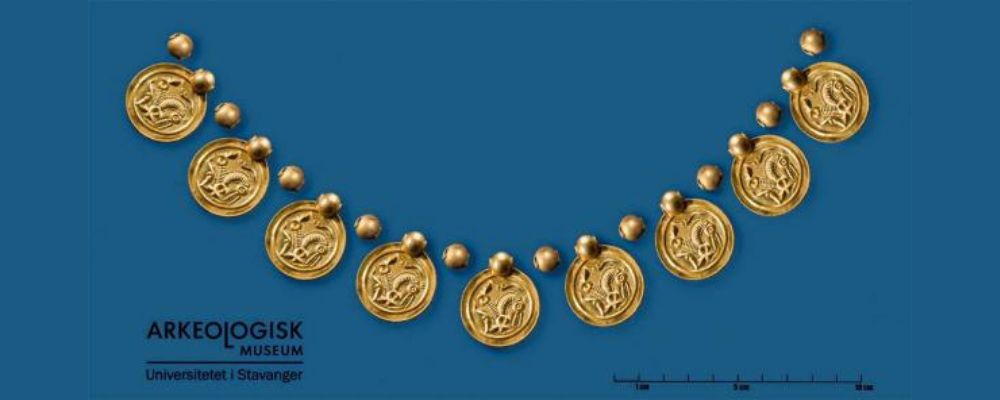While we might think of the Vikings as ancient history, our knowledge of what the Viking world was like is constantly evolving thanks to new archaeological discoveries.
New finds can push back the dates for important events, reveal greater spheres of influence, and elucidate rituals, fashions, and more.
With that in mind, here are some of the most exciting Viking archaeological finds from recent years. Some represent major revelations, while others are just cool.
Vindalev Hoard

The Vindalev Hoard was discovered near Jelling in Denmark by a metal detectorist in 2020.
It is a rich hoard containing 22 elaborate gold pieces.
While it was originally assumed that the hoard must relate to the cult center built at Jelling in the 10th century, it is now believed that the hoard is much older, dating to the Migration period, which is roughly the 6th century CE.
The hoard contains pieces that make interesting references to both the past and the future.
First, the hoard contained four Roman coins that had been fashioned into pendants. It is interesting that coins from the now-fallen empire were still valued as symbols of prestige.
Throughout the Viking period, foreign coins were turned into jewelry.
Looking forward, the hoard contained two gold bracteates.
These are coin-like medallions, but much thinner and only printed on one side, which means they are easier to make.
Both seem to represent Odin. One shows the face of a man with the runic inscription “The High One”.
He is accompanied by a horse and a bird, both of which are animals associated with Odin.
Ravens were considered familiars of Odin, in particular, he had two companion ravens, Huginn and Muninn.
In addition to his eight-legged steed Sleipnir, Odin was also associated with a story of him healing Balder’s horse, which was important in early Germanic mythology.
This suggests that the sophisticated mythology associated with Odin in the Viking age may already have been well-established even in the Migration period.
One bracteate also shows a Swastika alongside Odin, suggesting an association between the god and the symbol that has been usurped and corrupted in modern times.
Stavanger Gold Hoard

In 2023, another metal detectorist found a gold hoard around the islands of Stavanger.
It stands out because it includes 100 grams of gold, a small fortune even today.
This hoard also dates to the Migration Period, but a little bit earlier, between 400-550 CE.
The hoard contains three gold rings, nine gold medallions, and ten gold pearls, all of which seem to have been strung together to create a magnificent necklace.
Also unusually, all nine medallions feature the same image. It is a horse that looks like it is in pain with its tongue hanging out, a slumping posture, and twisted legs.
It is assumed that this is a simplified reference to the same myth of Odin healing Balder’s horse.
This symbol was linked to protection from sickness and also healing and new life.
It is assumed that this fine piece belonged to a high-status woman.
She may have hidden it to save it during a time of threat, or she may have given it as a sacrifice to the gods during a time of great need.
The Gullglubber

Representing a different kind of gold hoard, in the 2000s, 35 tiny, paper-thin, gold foil squares featuring images of the gods were found in Norway.
These were not the first examples of these gold foil figures found in Norway, but it is by far the highest concentration, and they were also found in an unexpected location.
They were found scattered around a very small structure.
It measures around 15 meters long.
For context, the average house was 20-30 meters long.
The foil figures were found close to the walls and in the post holes, suggesting that they were placed there while the building was being constructed.
This clearly indicates some kind of ritual action or cleansing, suggesting that this tiny building was a sacred space.
They date from the Merovingian period, which started around 550 CE, and feature representations of the gods.
The most famous example, seen above, is believed to depict the god Freyr and his consort Gerd.
The other, showing a woman with a staff, must be a representation of a Volva, a Viking witch, since they carried these types of staffs.
This could, therefore, be the goddess Freyja, as she was also considered a Volva.
The foils have been dubbed “gullglubber”, which means golden old men.
Trondheim Game Piece

In 2023, a single game piece was discovered in Norway, which offers additional confirmation of the Viking love of board games.
This discovery certainly doesn’t compare to the elaborate Viking chess pieces found in Scotland in the early 19th century and dating to the 12th century.
This piece dates to 1000-1100 CE.
But one thing that makes this piece fascinating is that the pattern on the piece, initially thought to be stylistic, is actually a runic inscription in the round. It reads “Siggsifr”.
Sigg means “struggle” while “sifr” is a poetical metaphor for a brother, which means that the inscription could mean “brother in arms”.
This could be a reference to the person who owned the piece, or the function of the piece in the game.
Combination Thor’s Hammer and Christian Cross

In 2023, this fascinating pendant in the shape of Thor’s Hammer but marked with a Christian Cross was discovered in the Ringsaker municipality of Norway.
It is one of only three other examples of a Christian Cross being inserted into a Mjolnir pendant.
One was found in Iceland and the other two in Norway.
But a casting mold showing that Mjolnir pendants and Christian crosses were produced in the same workshops has been found.
Mjolnir pendants were worn as symbols of the protection of the god Thor and general allegiance to the Norse religion.
The Christian Cross was worn for similar reasons, so it is perhaps not surprising that there was a conflation between the two images when the Vikings were converting to Christianity.
This confirms that conversion was not something that happened overnight. You were baptized by a visiting priest at the order of your local ruler and suddenly became a Christian.
The process of adoption and adaptation to Christianity was a slow process, and local beliefs and customs were integrated into the new Viking Christian world.







